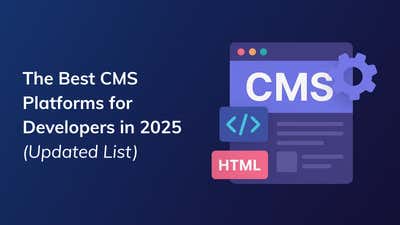The Best CMS Platforms for Developers in 2025 (Updated List)
You'll never guess what's #1


Original list can be found here
In 2025, developers demand CMS platforms that deliver flexibility, speed, and full control—without compromising on modern tech stacks like Jamstack or React. Whether you’re building a SaaS product, eCommerce site, or enterprise app, choosing the right CMS impacts scalability, team workflows, and time-to-market.
This guide cuts through the noise, comparing 10 CMS platforms optimized for developers in 2025. We’ll dive into API-first architectures, Jamstack compatibility, and why hybrid solutions like Agility CMS bridge the gap between developer freedom and marketer usability.
What Makes a CMS “Developer-Friendly” in 2025?
Modern developers prioritize tools that align with their tech stack and workflow. Key criteria include:
-
API-first architecture: REST/GraphQL APIs for headless content delivery.
-
Framework SDKs: Native support for Next.js, React, Vue, and SSGs like Gatsby.
-
Git/CI-CD workflows: Content versioning and seamless deployment.
-
Structured content: Flexible content modeling for omnichannel reuse.
-
Security & scalability: Enterprise-ready with minimal downtime.
Top CMS Platforms for Developers in 2025
1. Agility CMS
Type: Hybrid CMS (Headless + Visual UI)
Why Developers Love It:
-
REST & GraphQL APIs: Fetch content for any frontend.
-
Jamstack-ready: Integrates with Next.js, Nuxt, and Vercel.
-
Structured content: Visual modeling with reusable components.
-
Hybrid UI: Developers get API control; marketers enjoy drag-and-drop editing.
-
Best For: Teams needing both headless flexibility and marketer collaboration.
-
Bonus: Lightning-fast migration tools and best-in-class support.

Agility CMS combines structured content modeling with a developer-first API approach
2. Strapi
Type: Open-source Node.js CMS
Key Features:
-
Self-hosted or cloud.
-
GraphQL plugin & TypeScript support.
-
Customizable backend roles and permissions.
-
Best For: Developers who want full control over the backend.
3. Contentful
Type: Enterprise Headless CMS
Pros:
-
Robust composable content platform.
-
Strong React/Next.js integrations.
-
Cons: Steep learning curve and pricing for small teams.
-
Best For: Large-scale projects with complex content needs.
4. Sanity
Type: Developer-First Headless CMS
Standout Feature:
-
Real-time “Portable Text” editing.
-
Customizable React-powered studio.
-
Best For: Startups and enterprises prioritizing real-time collaboration.
5. Builder.io
Type: Visual CMS for Jamstack
Perks:
-
Drag-and-drop UI with Figma/Chrome plugins.
-
Works with existing codebases.
-
Best For: Teams blending no-code and code-first workflows.
6. WordPress (Headless Mode)
Type: Traditional CMS + REST API
Pros:
-
Massive plugin ecosystem.
-
Ideal for transitioning from monolithic setups.
-
Cons: Limited GraphQL support.
7. Ghost
Type: Node.js Publishing CMS
Perks:
-
Blazing-fast performance.
-
Built-in SEO tools.
-
Best For: Content-heavy sites (blogs, news).
8. Webflow (CMS API)
Type: Visual CMS + API
Use Case:
Export content via CMS API for Jamstack builds.
Best For: Designers and marketers collaborating with devs.
9. Directus
Type: Open Data Platform
Features:
-
Auto-generates REST/GraphQL APIs from SQL databases.
-
Extensible with Vue.js.
-
Best For: Managing SQL data with a headless layer.
10. KeystoneJS
Type: Node.js + GraphQL CMS
Perks:
-
Tailor-made for custom projects.
-
Strong TypeScript support.
-
Best For: Jamstack apps needing a bespoke backend.
How to Choose the Right CMS for Your Stack
Consider:
-
Framework compatibility: Does it support React, Vue, or your SSG?
-
Content modeling: Can you structure content for reuse?
-
DevOps: Git workflows, CI/CD pipelines, and deployment speed.
-
Use case: eCommerce, docs, apps, or multi-site?
-
Team skills: Will marketers need access?
Why Agility CMS Stands Out in 2025
-
Hybrid architecture: Headless APIs + visual content tools.
-
Jamstack-native: Deploy to Vercel, Netlify, or AWS.
-
Enterprise scalability: Built-in security and SLA guarantees.
-
Developer tools: SDKs, CLI, and 24/7 support.
👉 See How Agility Compares to Contentful
Conclusion
The best CMS for developers in 2025 depends on your stack and workflow:
-
Agility CMS: Best for teams needing flexibility + collaboration.
-
Strapi/KeystoneJS: Ideal for custom backends.
-
Contentful/Sanity: Top picks for enterprise-scale projects.
Ready to Build Faster?
→ Try Agility CMS Free
→ Book a Developer Demo

About the Author
Agility CMS is Canada's original headless CMS platform. Since 2002, Agility has helped companies across Canada and around the world better manage their content. Marketers are free to create the content they want, when they want it. Developers are empowered to build what they want, how they want.
- Get a demo for a personalized walkthrough.
- Try for FREE and experience Agility CMS.
- Contact us with your questions.


